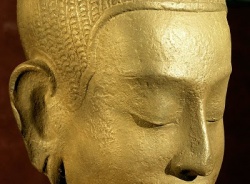Dhammasangani
The Dhammasangani (-saṅgaṇi or -ī) is a Buddhist scripture, part of the Pali Canon of Theravada Buddhism, where it is included in the Abhidhamma Pitaka.
Translations:
- A Buddhist Manual of Psychological Ethics, tr C. A. F. Rhys Davids, Royal Asiatic Society, 1900; reprinted with corrections, Pali Text Society, Bristol
- Tr U Kyaw Khine, Department for the Promotion and Propagation of the Sasana, Rangoon, ?1996; reprinted by Sri Satguru Pubns, Delhi, 2 volumes
The book begins with a matika (Pali for "matrix"), which is a list of classifications of dhammas, variously translated as ideas, phenomena, states, patterns etc. There are 22 3-fold classifications, followed by 100 2-fold ones according to the abhidhamma method and 42 according to the sutta method. The main body of the book is in four parts, as follows.
The first part deals with states of mind, listing and defining factors present in them.
The second deals with material phenomena, classifying them numerically, by ones, twos etc.
The third part applies the material in the first two to explaining the classifications in the matika.
The fourth does likewise, but in a different and sometimes more detailed way, and omitting the sutta method 2-fold classifications. This fourth part is mostly omitted from the old translation, only a few extracts being included. The new translation is complete.
Rhys Davids (1900) divisions of the text are as follows:
| Book I. The Genesis of Thoughts (cittuppaada- ka.n.da.m) |
Part I. Good States of Consciousness
|
Ch. I. The Eight Main Types of Thought relating to the Sensuous Universe (kaamaavacara-a.t.tha-mahaacittaani) Ch. II. Good in relation to the Universe of Form (ruupaavacara-kusala.m) |
| Part II. Bad States of Consciousness |
Ch. VI. The Twelve Bad Thoughts (dvaadasa akusalacittaani) | |
| Part III. Indeterminate States of Consciousness |
Ch. I. On Effect, or Result (vipaako): A. Good Karma. B. Bad Karma | |
| Book II. Form (rupa- ka.n.da.m) |
[No parts]
|
Ch. I. Exposition of Form under Single Concepts (ekaka-niddeso) Ch. II. Categories of Form under Dual Aspects — positive and negative |
| Book III. The Division Entitled 'Elimination' (nikkhepa- ka.n.da.m) |
Part I. [No title] |
Ch. I. The Group of Triplets (tika.m) Ch. II. The Group on Cause (hetu-gocchaka.m) |
| Part II. The Suttanta Pairs of Terms (suttantika-duka.m) |
[No chapter titles] |
Dhammasangani: The first book, in the accepted order of precedence, of The Abhidhamma Pitaka. It deals with more or less the same topics as the Nikāyas, differing only in methods of treatment; the chief subject is that of ethics, the enquiry there into being conducted from a psychological standpoint. The book enumerates and defines a number of categories of terms occurring in the Nikāyas.
There is in existence a commentary on the book, written by Buddhaghosa and called the Atthasālinī.
King Vijayabāhu I, of Ceylon translated the Dhammasangani into Sinhalese (Cv.lx.17), but this translation is now lost. The work has been translated into English. The text is published by the P.T.S. (1885), and the translation (by Mrs. Rhys Davids) is published by the R.A.S., under the title of A Buddhist Manual of Psychological Ethics.
The Dhammasangani appears to have been also called Dhammasangaha (DA.i.17).




